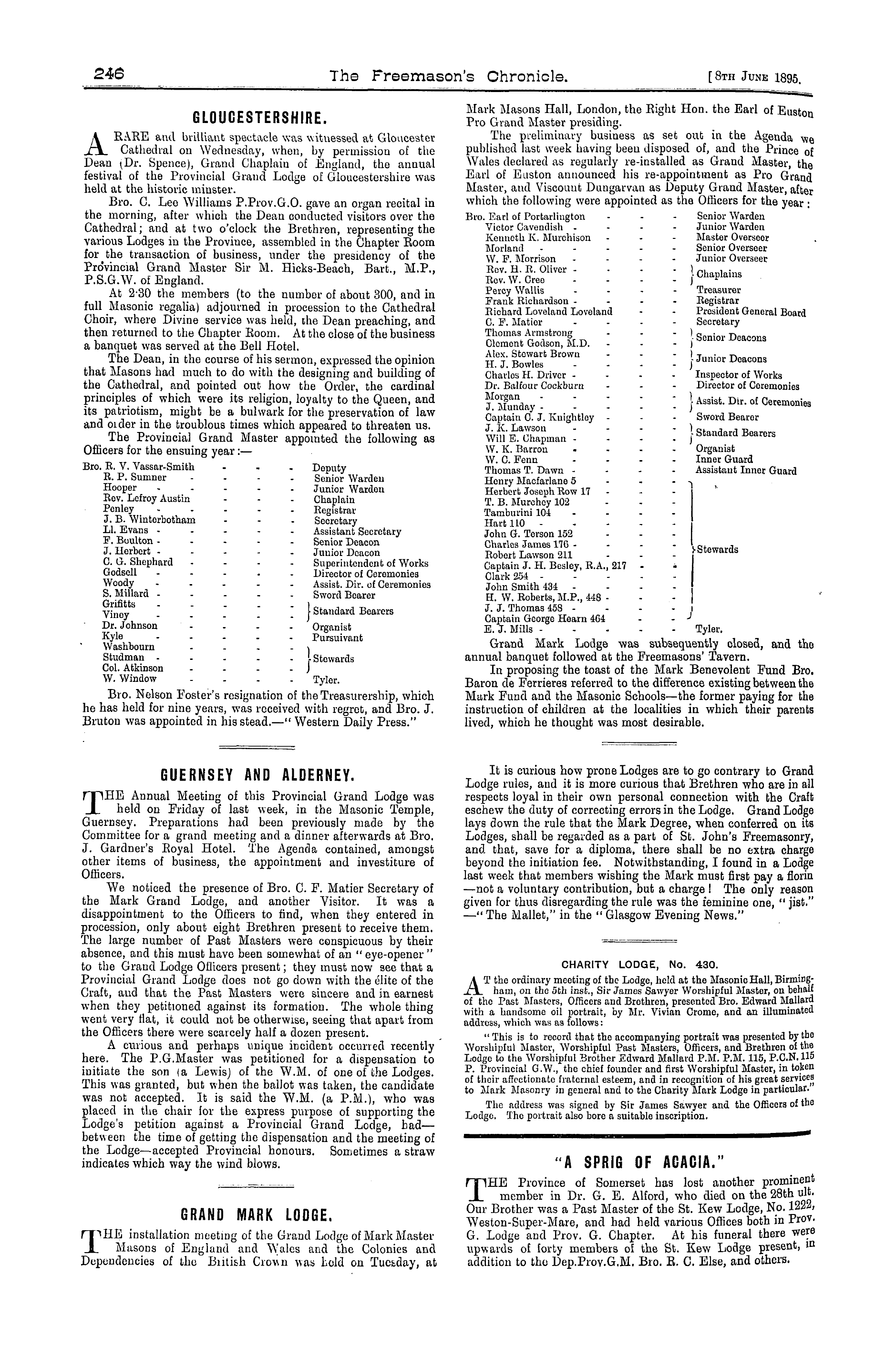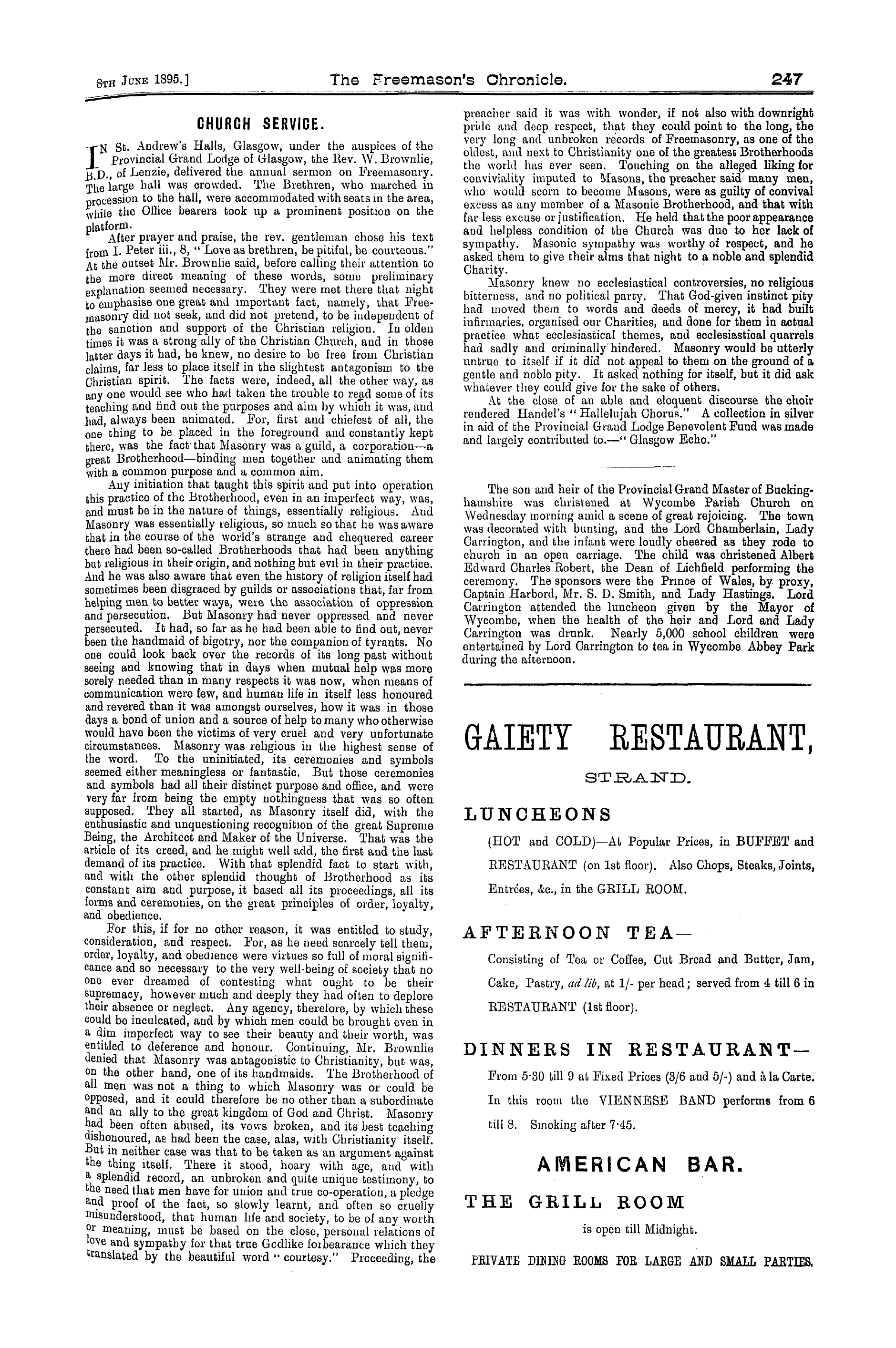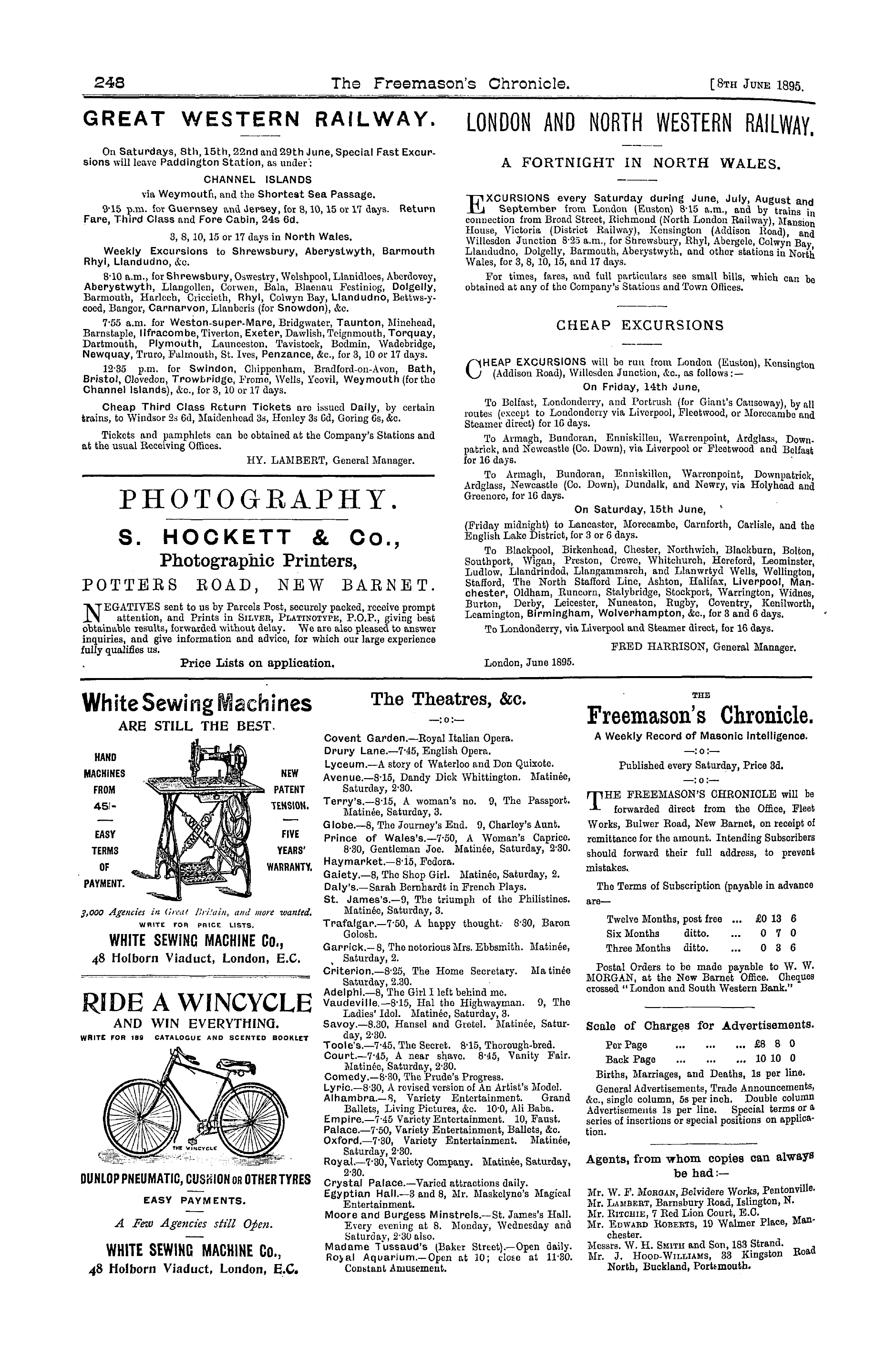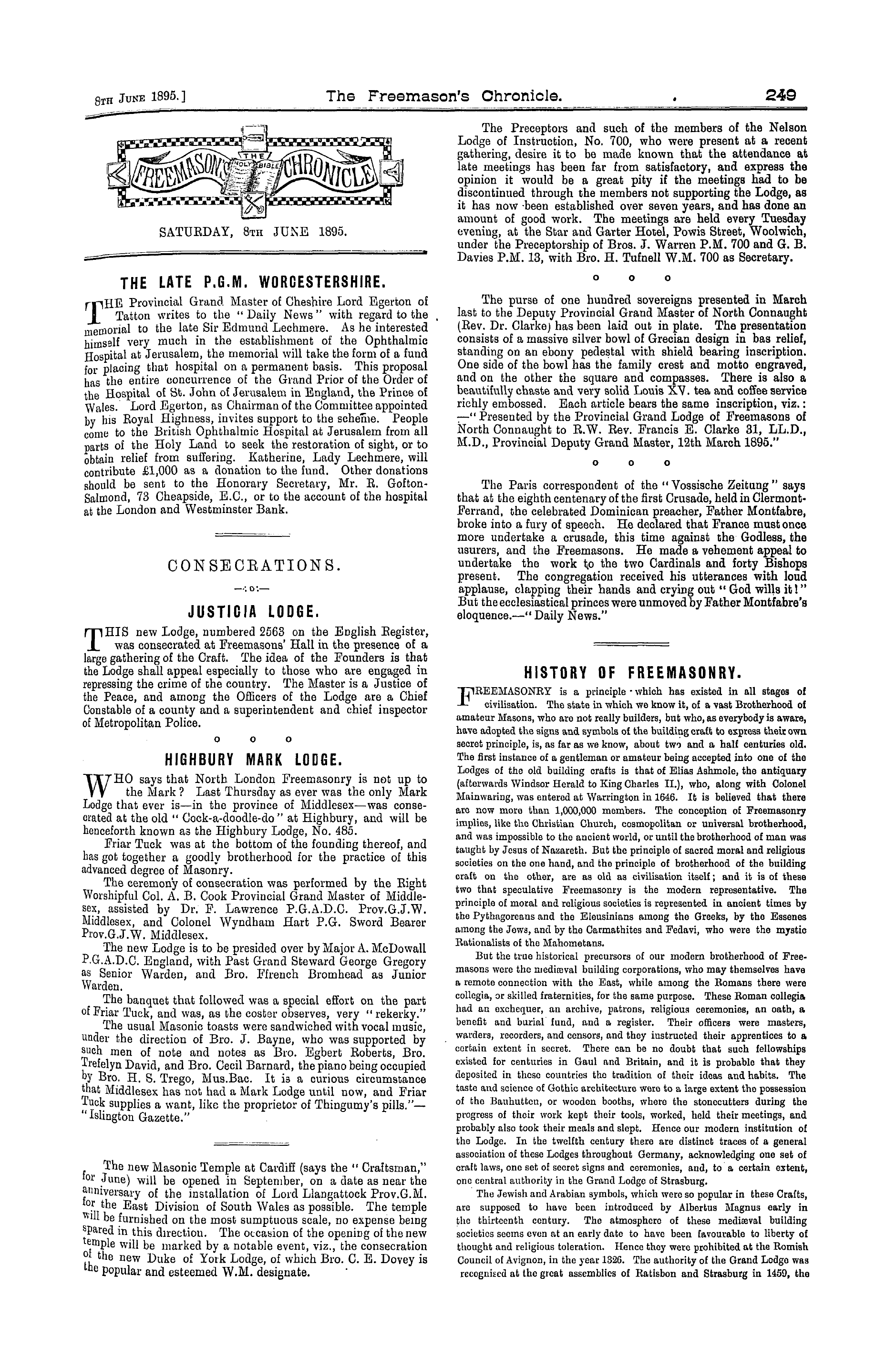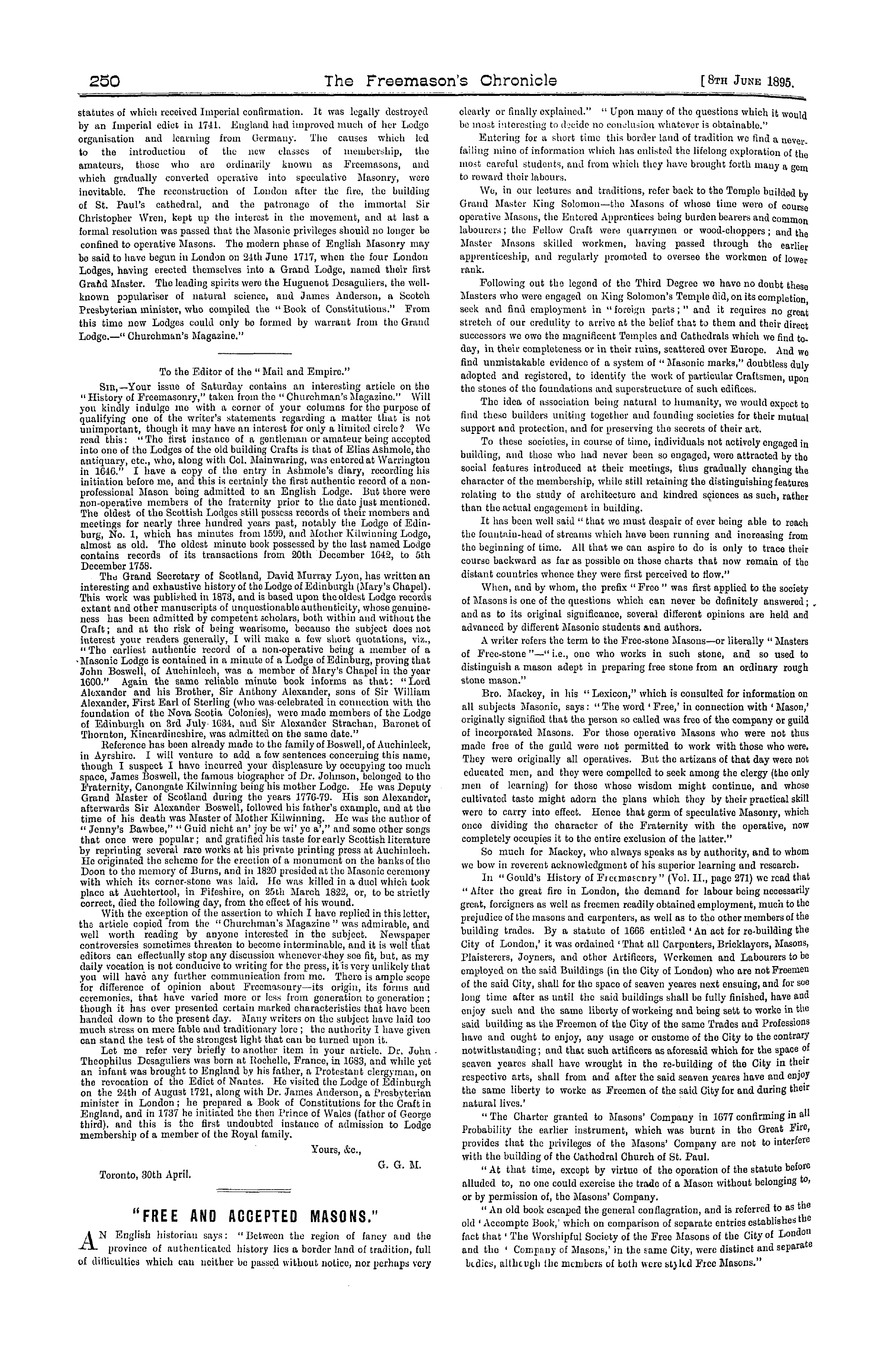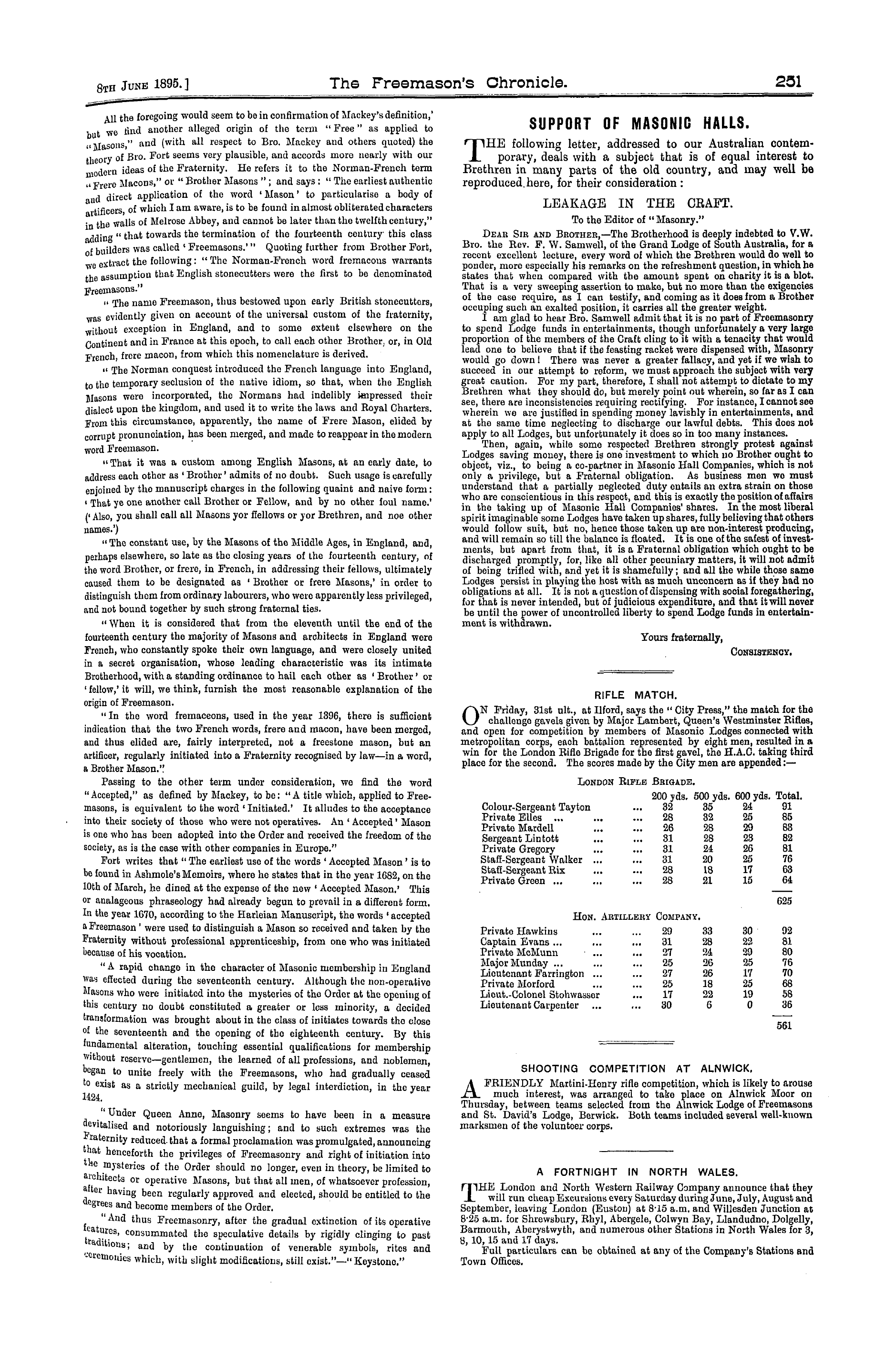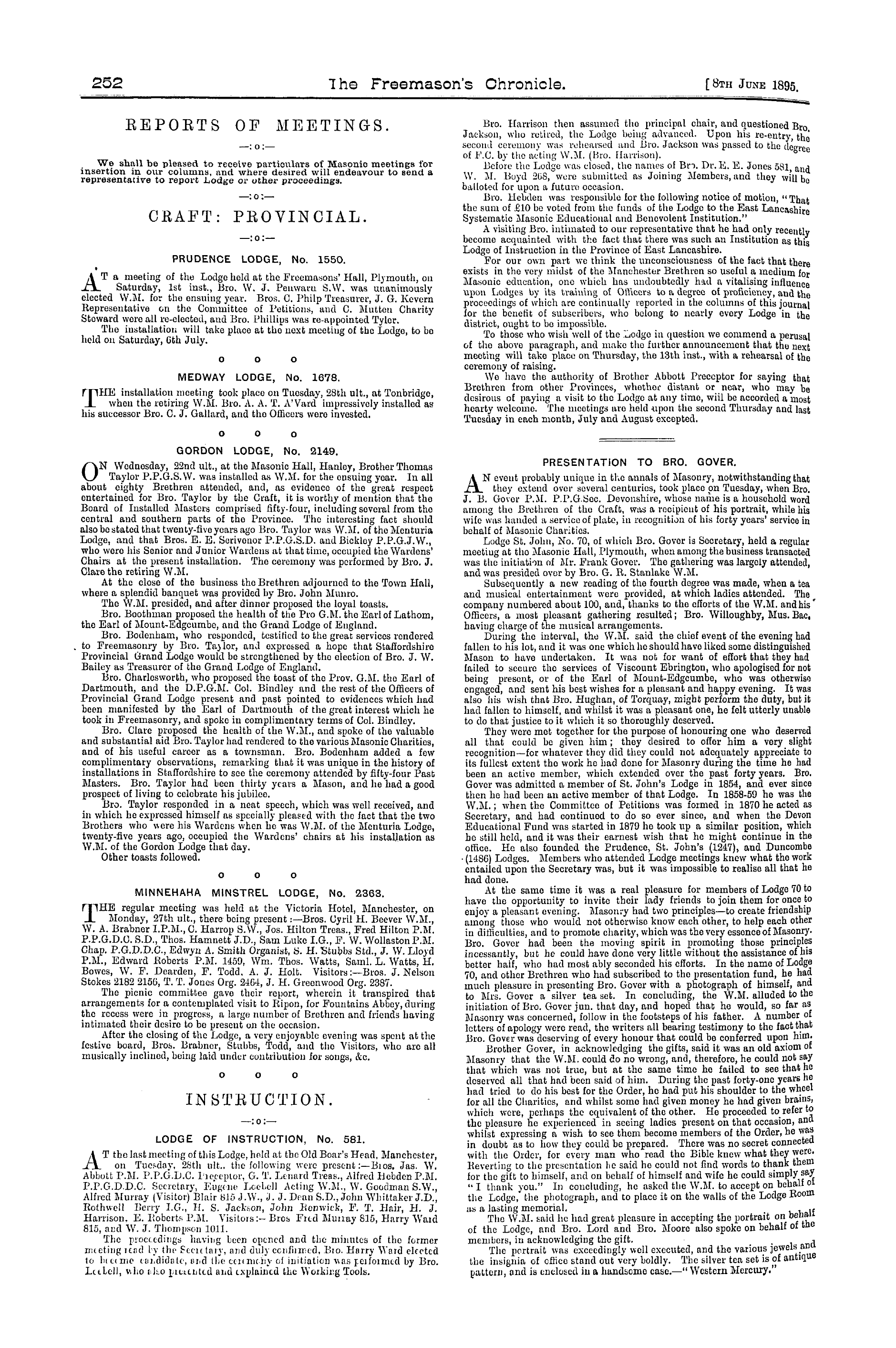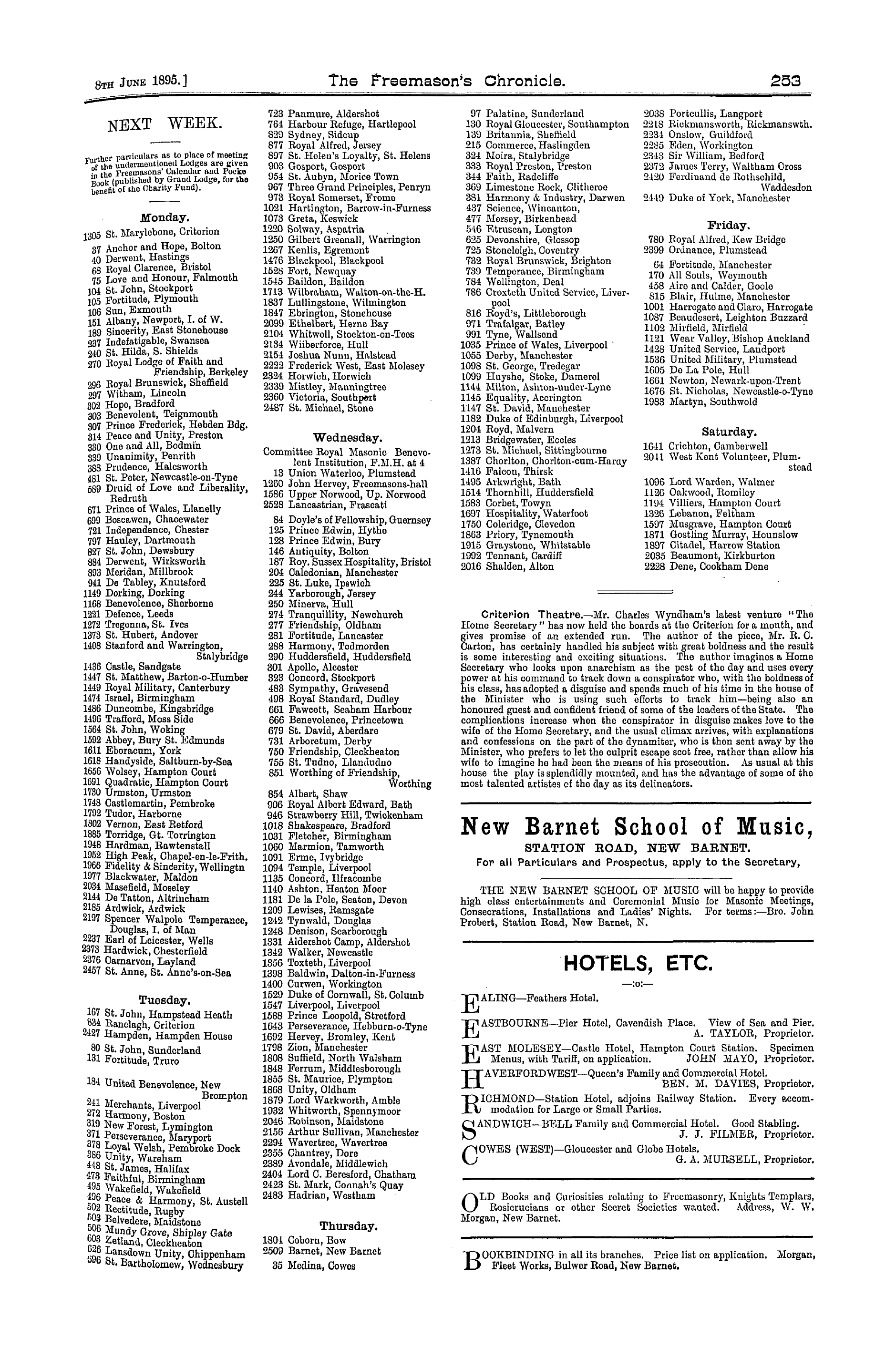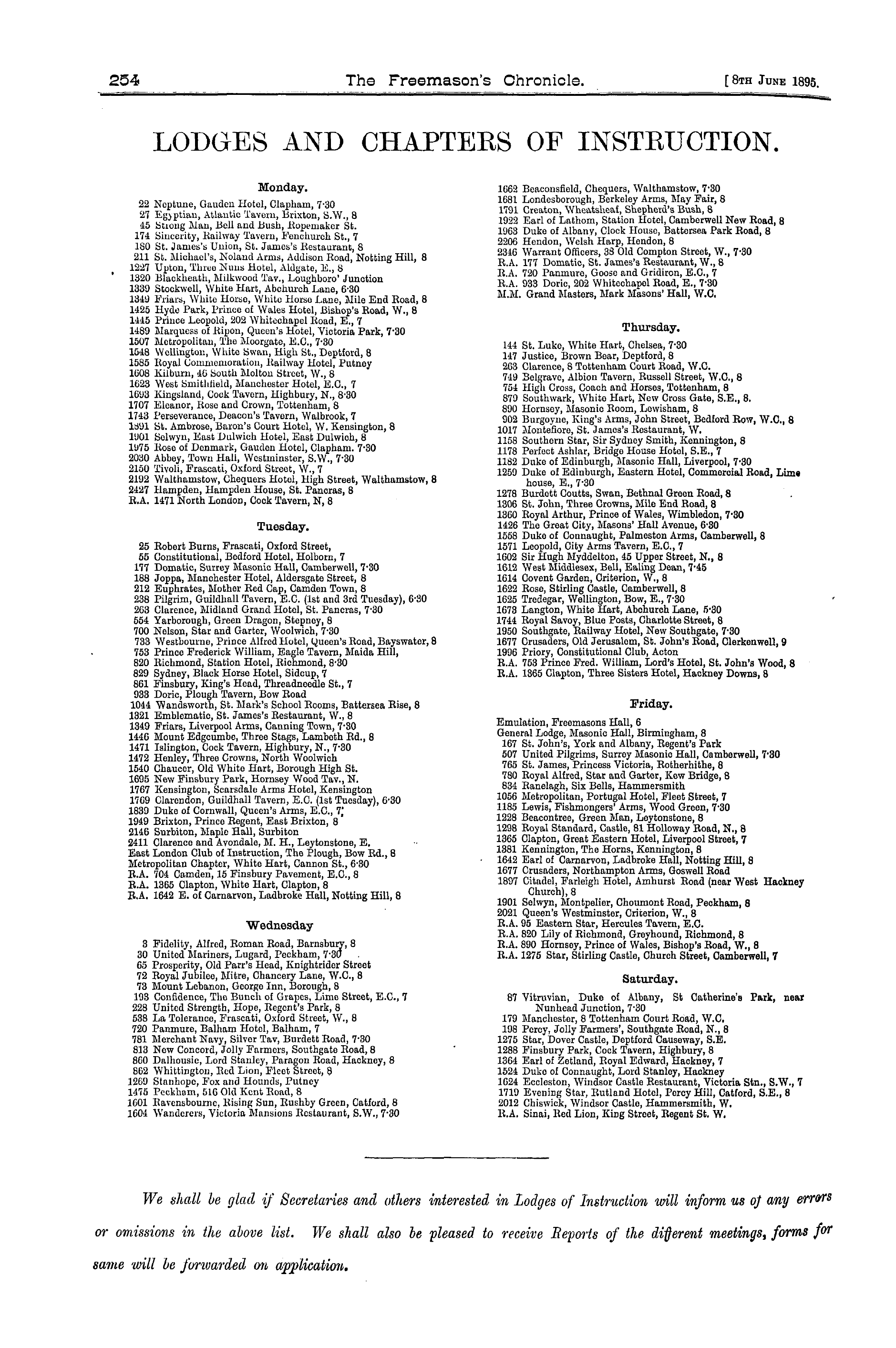-
Articles/Ads
Article HISTORY OF FREEMASONRY. ← Page 2 of 2 Article "FREE AND ACCEPTED MASONS." Page 1 of 2 Article "FREE AND ACCEPTED MASONS." Page 1 of 2 →
Note: This text has been automatically extracted via Optical Character Recognition (OCR) software.
History Of Freemasonry.
statutes of which received Imperial confirmation . It was legally destroyed by an Imperial edict in 1741 . England had improved much of her Lodgo organisation and learning from Germany . The causes which led to the introduction of the new classes of membership , the amateurs , those who are ordinarily known as Freemasons , and
which gradually converted operative into speculative Masonry , were inevitable . The reconstruction of Loudon after the fire , the building of St . Paul ' s cathedral , and the patronage of the immortal Sir Christopher Wren , kept up the interest in the movement , and at last a formal resolution was passed that the Masonic privileges should no longer be
confined to operative Masons . The modern phase of English Masonry may be said to have begun in London on 24 th June 1717 , when the four London Lodges , having erected themselves into a Grand Lodge , named their first Grand Master . The leading spirits wero the Huguenot Desaguliers , the
wellknown populariser of natural science , and James Anderson , a Scotch Presbyterian minister , who compiled the " Book of Constitutions . " From this timo now Lodges could only bo formed by warrant from tho Grand Lodge . — " Churchman's Magazine . "
To the Editor of the " Mail and Empire . " SIR , —Your issue of Saturday contains an interesting article on tho " History of Freemasonry , " taken from the " Churchman ' s Magazine . " Will you kindly indulge me with a corner of your columns for the purpose of qualifying one of tho writer's statements regarding a matter that is not unimportant , though it may have an interest for only a limited circle ? We
read this : " Tho first instance of a gentleman or amateur being accepted into one of tho Lodges of the old building Crafts is that of Elias Ashmole , tho antiquary , etc ., who , along with Col . Mainwaring , was entered at Warrington in 1646 . " I have a copy of the entry in Ashmole's diary , recording his initiation before me , and this is certainly the first authentic record of a nonprofessional Mason boing admitted to an English Lodge . But there were
non-operative members of tho fraternity prior to tho date just mentioned . The oldest of the Scottish Lodges still possess records o £ their members and meetings for nearly three hundred years past , notably the Lodge of Edinburgh No . 1 , which has minutes from 1599 , and Mother Kilwinning Lodge , almost as old . Tho oldest minute book possessed by the last named Lodge contains records of its transactions from 20 th December 1642 , to 5 th December 1758 .
The Grand Secretary of Scotland , David Murray Lyon , has written an interesting and exhaustive history of theLodge of Edinburgh ( Mary's Chapel ) . This work was published in 1873 , and is based upon the oldest Lodge records extant and other manuscripts of unquestionable authenticity , whose genuineness has been admitted by competent scholars , both within and without the Craft : and at tho risk of being wearisome , because the subject does not
interest your readers generally , I will make a few short quotations , viz ., " The earliest authentic record of a non-operative being a member of a Masonic Lodge is contained in a minute of a Lodge of Edinburg , proving that John Boswell , of Auchinlech , was a member of Mary's Chapel in the year 1600 . " Again the same reliable minute book informs as that : " Lord
Alexander and his Brother , Sir Anthony Alexander , sons of Sir William Alexander , First Earl of Sterling ( who was-celebrated in connection with tho foundation of the Nova Scotia Colonies ) , wero made members of the Lodge of Edinburgh on 3 rd July- 1 C 34 , aud Sir Alexander Strachan , Baronet ol Thornton , Kincardineshire , was admitted on the same date . "
Reference has been already made to the family of Boswell , of Auchinleck , in Ayrshire . I will venture to add a few sentences concerning this name , though I suspect I have incurred your displeasure by occupying too much space , James Boswell , the famous biographer of Dr . Johnson , belonged to tho Fraternity , Canongate Kilwinning being his mother Lodge . He was Deputy Grand Master of Scotland during the years 1776-79 . His son Alexander ,
afterwards Sir Alexander Boswell , followed his father's example , and at the time of his death was Master of Mother Kilwinning . He was the author of " Jenny ' s Bawbee , " " Guid nicht an' joy be wi' ye a ' , " and somo other songs that once were popular ; and gratified his taste for early Scottish literature by reprinting several rare works at his private printing press at Auchinlech .
He originated the scheme for the erection of a monument on the banks of the Doon to tho memory of Burns , and in 1820 presided at the Masonic ceremony with which its corner-stone was laid . Ho was killed in a duel which took place at Auchtertool , in Fifeshire , on 25 th March 1822 , or , to be strictly correct , died the following day , from the effect of his wound .
With the exception of the assertion to which I have replied in this letter , the article copied from the " Churchman ' s Magazine " was admirable , and well worth reading by anyone interested in the subject . Newspaper controversies sometimes threaten to become interminable , and it is well that editors can effectually stop any discussion whenever-they see fit , but , as my daily vocation is not conducive to writing for the press , it is very unlikely that
you will have any further communication from me . There is ample scope for difference of opinion about Freemasonry—its origin , its forms aud ceremonies , that have varied more or less from generation to generation ; though it has ever presented certain marked characteristics that havo been handed clown to tho present day . Many writers on the subject have laid too much stress on mere fable ancl traditionary lore ; the authority I have given can stand the test of the strongest light that can be turned upon it .
Let me refer very briefly to another item in your article . Dr . John Theophilus Desaguliers was born at Rochellc , France , in 1 C 83 , and while yet an infant was brought to England by his father , a Protestant clergyman , on the revocation of the Edict of Nantes . He visited the Lodge of Edinburgh
on the 24 th of August 1721 , along with Dr . James Anderson , a Presbyterian minister in London ; he prepared a Book of Constitutions for the Craft in England , and in 1737 he initiated the then Prince of Wales ( father of George third ) , and this is the first undoubted instance of admission to Lodge membership of a member of the Royal family . Yours , & C ,
G . G . M . Toronto , 30 th April .
"Free And Accepted Masons."
" FREE AND ACCEPTED MASONS . "
AN English historian says : " Between the region of fancy aud the province of authenticated history lies a border land of tradition , full of difficulties whieh can neither be passed without notice , nor perhaps very
"Free And Accepted Masons."
clearly or finally explained . " " Upon many of the questions which it would be most interesting to decide no conclusion whatever is obtainable . " Entering for a short time this border land of tradition we find a neverfailing mine of information which has enlisted tho lifelong exploration of tho most careful students , and from which thoy have brought forth many a gem to reward their labours .
We , in our lectures and traditions , refer back to the Temple builded bv Grand Master King Solomon—tho Masons of whose time were of course operative Masons , the Entered Apprentices being burden bearers and common
labourers ; the Fellow Craft wero quarrymen or wood-choppers ; and the Master Masons skilled workmen , having passed through the earlier apprenticeship , and regularly promoted to oversee the workmen of lower rank .
Following out tho legend of thc Third Degree we have no doubt theso Masters who were engaged on King Solomon ' s Temple did , on its completion seek and find employment in " foreign parts ; " and it requires no "teat stretch of our credulity to arrive at the belief that to them and their direct
successors we owe the magnificent Temples and Cathedrals which we find today , in their completeness or in their ruins , scattered over Europe . And we find unmistakable evidence of a system of " Masonic marks , " doubtless duly adopted and registered , to identify the work of particular Craftsmen , upon the stones of tho foundations and superstructure of such edifices .
The idea of association boing natural to humanity , wo would expect to find these builders uniting together and founding societies for their mutual support and protection , and for preserving the secrets of their art . To these societies , in course of time , individuals not actively engaged in
building , aud thoso who had never been so engaged , were attracted by tho social features introduced at their meetings , thus gradually changing the character of the membership , while still retaining the distinguishing features relating to tho study of architecture and kindred sciences as such , rather than the actual engagement in building .
It has boon well said " that we must despair of ever being able to reach the fountain-head of streams which have been running and increasing from tho beginning of time . All that we can aspire to do is only to trace their course backward as far as possible on thoso charts that now remain of tho distant countries whence they were first perceived to flow . "
When , and by whom , the prefix " Free " was first applied to the society of Masons is one of the questions which can never be definitely answered ; and as to its original significance , several different opinions are held and advanced by different Masonic students and authors .
A writer refers the term to the Free-stone Masons—or literally " Masters of Free-stone "— " i . e ., one who works in such stone , and so used to distinguish a mason adept in preparing free stone from an ordinary rough stone mason . "
Bro . Mackey , in his " Lexicon , " which is consulted for information on all subjects Masonic , says : " The word ' Free , ' in connection with ' Mason , ' originally signified that the person so called was free of the company or guild of incorporated Masons . For those operative Masons who were not thus made free of tho guild were not permitted to work with those who were .
They wore originally all operatives . But thc artizans of that day were not educated men , and they were compelled to seek among the clergy ( the only men of learning ) for thoso whose wisdom might continue , and whose cultivated taste might adorn the plans which they by their practical skill
wero to carry into effect . Hence that germ of speculative Masonry , which once dividing the character of the Fraternity with the operative , now completely occupies it to the entire exclusion of the latter . " So much for Mackey , who always speaks as by authority , and to whom wc bow in reverent acknowledgment of his superior learning and research .
In " Gould ' s History of Ficcmescnry " ( Vol . II ., page 271 ) we read that " After thc great fire in London , the demand for labour being necessarily great , foreigners as well as freemen readily obtained employment , much to the prejudice of the masons and carpenters , as well as to the other members of the building trades . By a statute of 1666 entitled ' An act for re-building the
City of London , ' it was ordained ' That all Carpenters , Bricklayers , Masons , Plaisterers , Joyners , ancl other Artificers , Wcrkeinen and Labourers to bo employed on the said Buildings ( in the City of London ) who are not Freemen of the said City , shall for the space of seaven yeares next ensuing , and for see long time after as until thc said buildings shall be fully finished , have and
enjoy such and the same liberty of workeing and being sett to worke in the said building as the Freemen of the City of the same Trades and Professions have and ought to enjoy , any usage or custome of the City to the contrary notwithstanding ; ancl that such artificers as aforesaid which for the space of
seaven yeares shall have wrought in the re-building of the City in their respective arts , shall from and after the said seaven yeares have and enjoy the samo liberty to worke as Freemen of the said City for and during their natural lives . '
" The Charter granted to Masons' Company in 1677 confirming in all Probability the earlier instrument , which was burnt in tho Great Fire , provides that the privileges of tho Masons' Company are not to interfere with the building of the Cathedral Church of St . Paul . " At that time , except by virtue of the operation of the statute before alluded to , no one could exercise the trade of a Mason without belonging to ,
or by permission of , the Masons' Company . " An old book escaped the general conflagration , and is referred to as tne old ' xVccompte Book , ' which on comparison of separate entries establishes tn fact that' The Worshipful Society of the Free Masons of the City of London and the ' Company of Masons , ' in the same City , were distinct and separate btdies , although the members of both were stykd Free Masons . "
Note: This text has been automatically extracted via Optical Character Recognition (OCR) software.
History Of Freemasonry.
statutes of which received Imperial confirmation . It was legally destroyed by an Imperial edict in 1741 . England had improved much of her Lodgo organisation and learning from Germany . The causes which led to the introduction of the new classes of membership , the amateurs , those who are ordinarily known as Freemasons , and
which gradually converted operative into speculative Masonry , were inevitable . The reconstruction of Loudon after the fire , the building of St . Paul ' s cathedral , and the patronage of the immortal Sir Christopher Wren , kept up the interest in the movement , and at last a formal resolution was passed that the Masonic privileges should no longer be
confined to operative Masons . The modern phase of English Masonry may be said to have begun in London on 24 th June 1717 , when the four London Lodges , having erected themselves into a Grand Lodge , named their first Grand Master . The leading spirits wero the Huguenot Desaguliers , the
wellknown populariser of natural science , and James Anderson , a Scotch Presbyterian minister , who compiled the " Book of Constitutions . " From this timo now Lodges could only bo formed by warrant from tho Grand Lodge . — " Churchman's Magazine . "
To the Editor of the " Mail and Empire . " SIR , —Your issue of Saturday contains an interesting article on tho " History of Freemasonry , " taken from the " Churchman ' s Magazine . " Will you kindly indulge me with a corner of your columns for the purpose of qualifying one of tho writer's statements regarding a matter that is not unimportant , though it may have an interest for only a limited circle ? We
read this : " Tho first instance of a gentleman or amateur being accepted into one of tho Lodges of the old building Crafts is that of Elias Ashmole , tho antiquary , etc ., who , along with Col . Mainwaring , was entered at Warrington in 1646 . " I have a copy of the entry in Ashmole's diary , recording his initiation before me , and this is certainly the first authentic record of a nonprofessional Mason boing admitted to an English Lodge . But there were
non-operative members of tho fraternity prior to tho date just mentioned . The oldest of the Scottish Lodges still possess records o £ their members and meetings for nearly three hundred years past , notably the Lodge of Edinburgh No . 1 , which has minutes from 1599 , and Mother Kilwinning Lodge , almost as old . Tho oldest minute book possessed by the last named Lodge contains records of its transactions from 20 th December 1642 , to 5 th December 1758 .
The Grand Secretary of Scotland , David Murray Lyon , has written an interesting and exhaustive history of theLodge of Edinburgh ( Mary's Chapel ) . This work was published in 1873 , and is based upon the oldest Lodge records extant and other manuscripts of unquestionable authenticity , whose genuineness has been admitted by competent scholars , both within and without the Craft : and at tho risk of being wearisome , because the subject does not
interest your readers generally , I will make a few short quotations , viz ., " The earliest authentic record of a non-operative being a member of a Masonic Lodge is contained in a minute of a Lodge of Edinburg , proving that John Boswell , of Auchinlech , was a member of Mary's Chapel in the year 1600 . " Again the same reliable minute book informs as that : " Lord
Alexander and his Brother , Sir Anthony Alexander , sons of Sir William Alexander , First Earl of Sterling ( who was-celebrated in connection with tho foundation of the Nova Scotia Colonies ) , wero made members of the Lodge of Edinburgh on 3 rd July- 1 C 34 , aud Sir Alexander Strachan , Baronet ol Thornton , Kincardineshire , was admitted on the same date . "
Reference has been already made to the family of Boswell , of Auchinleck , in Ayrshire . I will venture to add a few sentences concerning this name , though I suspect I have incurred your displeasure by occupying too much space , James Boswell , the famous biographer of Dr . Johnson , belonged to tho Fraternity , Canongate Kilwinning being his mother Lodge . He was Deputy Grand Master of Scotland during the years 1776-79 . His son Alexander ,
afterwards Sir Alexander Boswell , followed his father's example , and at the time of his death was Master of Mother Kilwinning . He was the author of " Jenny ' s Bawbee , " " Guid nicht an' joy be wi' ye a ' , " and somo other songs that once were popular ; and gratified his taste for early Scottish literature by reprinting several rare works at his private printing press at Auchinlech .
He originated the scheme for the erection of a monument on the banks of the Doon to tho memory of Burns , and in 1820 presided at the Masonic ceremony with which its corner-stone was laid . Ho was killed in a duel which took place at Auchtertool , in Fifeshire , on 25 th March 1822 , or , to be strictly correct , died the following day , from the effect of his wound .
With the exception of the assertion to which I have replied in this letter , the article copied from the " Churchman ' s Magazine " was admirable , and well worth reading by anyone interested in the subject . Newspaper controversies sometimes threaten to become interminable , and it is well that editors can effectually stop any discussion whenever-they see fit , but , as my daily vocation is not conducive to writing for the press , it is very unlikely that
you will have any further communication from me . There is ample scope for difference of opinion about Freemasonry—its origin , its forms aud ceremonies , that have varied more or less from generation to generation ; though it has ever presented certain marked characteristics that havo been handed clown to tho present day . Many writers on the subject have laid too much stress on mere fable ancl traditionary lore ; the authority I have given can stand the test of the strongest light that can be turned upon it .
Let me refer very briefly to another item in your article . Dr . John Theophilus Desaguliers was born at Rochellc , France , in 1 C 83 , and while yet an infant was brought to England by his father , a Protestant clergyman , on the revocation of the Edict of Nantes . He visited the Lodge of Edinburgh
on the 24 th of August 1721 , along with Dr . James Anderson , a Presbyterian minister in London ; he prepared a Book of Constitutions for the Craft in England , and in 1737 he initiated the then Prince of Wales ( father of George third ) , and this is the first undoubted instance of admission to Lodge membership of a member of the Royal family . Yours , & C ,
G . G . M . Toronto , 30 th April .
"Free And Accepted Masons."
" FREE AND ACCEPTED MASONS . "
AN English historian says : " Between the region of fancy aud the province of authenticated history lies a border land of tradition , full of difficulties whieh can neither be passed without notice , nor perhaps very
"Free And Accepted Masons."
clearly or finally explained . " " Upon many of the questions which it would be most interesting to decide no conclusion whatever is obtainable . " Entering for a short time this border land of tradition we find a neverfailing mine of information which has enlisted tho lifelong exploration of tho most careful students , and from which thoy have brought forth many a gem to reward their labours .
We , in our lectures and traditions , refer back to the Temple builded bv Grand Master King Solomon—tho Masons of whose time were of course operative Masons , the Entered Apprentices being burden bearers and common
labourers ; the Fellow Craft wero quarrymen or wood-choppers ; and the Master Masons skilled workmen , having passed through the earlier apprenticeship , and regularly promoted to oversee the workmen of lower rank .
Following out tho legend of thc Third Degree we have no doubt theso Masters who were engaged on King Solomon ' s Temple did , on its completion seek and find employment in " foreign parts ; " and it requires no "teat stretch of our credulity to arrive at the belief that to them and their direct
successors we owe the magnificent Temples and Cathedrals which we find today , in their completeness or in their ruins , scattered over Europe . And we find unmistakable evidence of a system of " Masonic marks , " doubtless duly adopted and registered , to identify the work of particular Craftsmen , upon the stones of tho foundations and superstructure of such edifices .
The idea of association boing natural to humanity , wo would expect to find these builders uniting together and founding societies for their mutual support and protection , and for preserving the secrets of their art . To these societies , in course of time , individuals not actively engaged in
building , aud thoso who had never been so engaged , were attracted by tho social features introduced at their meetings , thus gradually changing the character of the membership , while still retaining the distinguishing features relating to tho study of architecture and kindred sciences as such , rather than the actual engagement in building .
It has boon well said " that we must despair of ever being able to reach the fountain-head of streams which have been running and increasing from tho beginning of time . All that we can aspire to do is only to trace their course backward as far as possible on thoso charts that now remain of tho distant countries whence they were first perceived to flow . "
When , and by whom , the prefix " Free " was first applied to the society of Masons is one of the questions which can never be definitely answered ; and as to its original significance , several different opinions are held and advanced by different Masonic students and authors .
A writer refers the term to the Free-stone Masons—or literally " Masters of Free-stone "— " i . e ., one who works in such stone , and so used to distinguish a mason adept in preparing free stone from an ordinary rough stone mason . "
Bro . Mackey , in his " Lexicon , " which is consulted for information on all subjects Masonic , says : " The word ' Free , ' in connection with ' Mason , ' originally signified that the person so called was free of the company or guild of incorporated Masons . For those operative Masons who were not thus made free of tho guild were not permitted to work with those who were .
They wore originally all operatives . But thc artizans of that day were not educated men , and they were compelled to seek among the clergy ( the only men of learning ) for thoso whose wisdom might continue , and whose cultivated taste might adorn the plans which they by their practical skill
wero to carry into effect . Hence that germ of speculative Masonry , which once dividing the character of the Fraternity with the operative , now completely occupies it to the entire exclusion of the latter . " So much for Mackey , who always speaks as by authority , and to whom wc bow in reverent acknowledgment of his superior learning and research .
In " Gould ' s History of Ficcmescnry " ( Vol . II ., page 271 ) we read that " After thc great fire in London , the demand for labour being necessarily great , foreigners as well as freemen readily obtained employment , much to the prejudice of the masons and carpenters , as well as to the other members of the building trades . By a statute of 1666 entitled ' An act for re-building the
City of London , ' it was ordained ' That all Carpenters , Bricklayers , Masons , Plaisterers , Joyners , ancl other Artificers , Wcrkeinen and Labourers to bo employed on the said Buildings ( in the City of London ) who are not Freemen of the said City , shall for the space of seaven yeares next ensuing , and for see long time after as until thc said buildings shall be fully finished , have and
enjoy such and the same liberty of workeing and being sett to worke in the said building as the Freemen of the City of the same Trades and Professions have and ought to enjoy , any usage or custome of the City to the contrary notwithstanding ; ancl that such artificers as aforesaid which for the space of
seaven yeares shall have wrought in the re-building of the City in their respective arts , shall from and after the said seaven yeares have and enjoy the samo liberty to worke as Freemen of the said City for and during their natural lives . '
" The Charter granted to Masons' Company in 1677 confirming in all Probability the earlier instrument , which was burnt in tho Great Fire , provides that the privileges of tho Masons' Company are not to interfere with the building of the Cathedral Church of St . Paul . " At that time , except by virtue of the operation of the statute before alluded to , no one could exercise the trade of a Mason without belonging to ,
or by permission of , the Masons' Company . " An old book escaped the general conflagration , and is referred to as tne old ' xVccompte Book , ' which on comparison of separate entries establishes tn fact that' The Worshipful Society of the Free Masons of the City of London and the ' Company of Masons , ' in the same City , were distinct and separate btdies , although the members of both were stykd Free Masons . "

